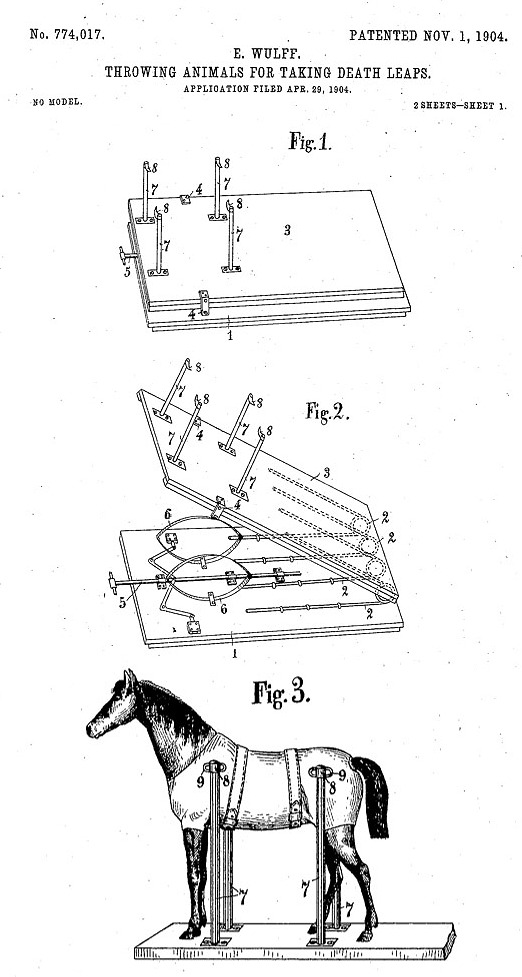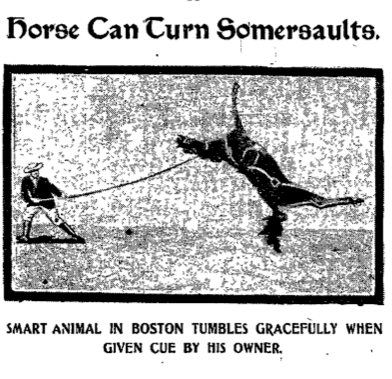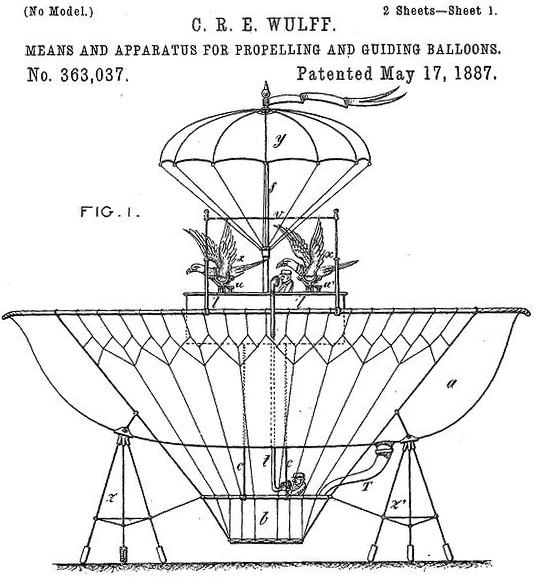Throwing Animals for Taking Death Leaps
Circus proprietor Edward Wulff patented a curious device in 1904. It was an apparatus that catapulted animals upwards. It had the rather alarming title, "Throwing Animals For Taking Death Leaps" (Patent No. 774,017). Wulff claimed it could throw "horses, elephants, monkeys, &c.." The patent illustration shows a horse, so these were evidently the primary animal being thrown.

The device was relatively straight-forward. The animals were placed in a harness that held them on top of a spring-powered platform. The release of the springs then flung the animals upwards. Wulff emphasized that his apparatus was designed, via the harness, to place the projecting force on the full body of the animal, rather than just their legs. He seemed to feel that this was a safer, more humane method of throwing animals.
Wulff explained that this device was designed to be used as part of a circus stunt known as "a death leap or so-called 'salto-mortale.'" But he didn't offer any further explanation about the nature of the stunt or how far the animals were flung. And I couldn't locate any descriptions of this stunt in other sources. All the references to a 'death leap' stunt that I came across involved human trapeze artists, not animals. So I was about to conclude that the stunt would have to remain a mystery until I got the idea to check if Wulff had filed the patent in any other countries. Sure enough, there was a British version of the patent, and while its text was almost identical, it had a different title that explained the nature of the stunt:
So Wullf's apparatus was evidently designed to somersault animals. Not simply to catapult them upwards. This made me recall something I posted here on WU back in 2012. It was a brief item that appeared on the front page of the Washington Post's 'Miscellany Section' on April 21, 1907, titled 'Horse Can Turn Somersaults.' At the time, this random reference to a somersaulting horse totally baffled me. I even suspected it was a hoax. But now it makes sense. It must have been a circus stunt. Perhaps it even made use of Wulff's invention. I can't find any evidence that Wulff's circus was in Boston in April 1907, but it was in New York in December of that year.

Wulff, it turns out, was the author of another odd patent, granted to him in 1887. The patent was titled, "Means and apparatus for propelling and guiding balloons." He intended to use birds such as "eagles, vultures, condors, &c" to guide balloons. The birds would be attached to the balloon by a harness, and an aeronaut would then force them to fly in the desired direction, thereby propelling the balloon.

This patent has received quite a bit of attention, because there's a lot of interest in the history of early attempts at flying machines. Knowing that Wulff was a circus proprietor, I wonder if he intended his eagle-guided balloon to be used as part of a circus act, rather than as a practical flying machine.

The device was relatively straight-forward. The animals were placed in a harness that held them on top of a spring-powered platform. The release of the springs then flung the animals upwards. Wulff emphasized that his apparatus was designed, via the harness, to place the projecting force on the full body of the animal, rather than just their legs. He seemed to feel that this was a safer, more humane method of throwing animals.
Wulff explained that this device was designed to be used as part of a circus stunt known as "a death leap or so-called 'salto-mortale.'" But he didn't offer any further explanation about the nature of the stunt or how far the animals were flung. And I couldn't locate any descriptions of this stunt in other sources. All the references to a 'death leap' stunt that I came across involved human trapeze artists, not animals. So I was about to conclude that the stunt would have to remain a mystery until I got the idea to check if Wulff had filed the patent in any other countries. Sure enough, there was a British version of the patent, and while its text was almost identical, it had a different title that explained the nature of the stunt:
Improvements in Apparatus for Throwing Animals to take a Somersault.
So Wullf's apparatus was evidently designed to somersault animals. Not simply to catapult them upwards. This made me recall something I posted here on WU back in 2012. It was a brief item that appeared on the front page of the Washington Post's 'Miscellany Section' on April 21, 1907, titled 'Horse Can Turn Somersaults.' At the time, this random reference to a somersaulting horse totally baffled me. I even suspected it was a hoax. But now it makes sense. It must have been a circus stunt. Perhaps it even made use of Wulff's invention. I can't find any evidence that Wulff's circus was in Boston in April 1907, but it was in New York in December of that year.

Wulff, it turns out, was the author of another odd patent, granted to him in 1887. The patent was titled, "Means and apparatus for propelling and guiding balloons." He intended to use birds such as "eagles, vultures, condors, &c" to guide balloons. The birds would be attached to the balloon by a harness, and an aeronaut would then force them to fly in the desired direction, thereby propelling the balloon.

This patent has received quite a bit of attention, because there's a lot of interest in the history of early attempts at flying machines. Knowing that Wulff was a circus proprietor, I wonder if he intended his eagle-guided balloon to be used as part of a circus act, rather than as a practical flying machine.
Comments
"Fetchez la vache."
"Quoi?"
"Fetchez la vache!!"
"Quoi?"
"Fetchez la vache!!"
Posted by KDP on 02/09/20 at 10:35 AM
Also suitable for throwing BYU mascots?
Posted by crc on 02/10/20 at 05:28 AM
KDP, there is no "Fetchez" in French. Depending if you are before or after the throw, it's either "Allez chercher la vache" or "Cherchez la vache".
Posted by Yudith on 02/12/20 at 06:11 AM
That's not strictly French, Yudith. It's associated with a certain Holy Grail...
Posted by KDP on 02/12/20 at 09:54 AM
I understand that the people in Quebec have their own dialect, Joual (https://en.wikipedia.org/wiki/Joual). An auto repair place might have a sign saying "Nous fixons votre car." (Or at least that is what a Canadian bunk mate told me at summer camp in Upstate New York.)
Posted by Joshua Zev Levin, Ph.D. on 02/12/20 at 09:50 PM
Speaking of balloons, it turns out that Count von Zeppelin was introduced to lighter-than-air aviation on these shores. He was an embedded military observer in the Union Army during the Civil War. See https://militaryimages.atavist.com/americas-champion-aeronaut-in-the-civil-war-autumn-2015
Posted by Joshua Zev Levin, Ph.D. on 02/12/20 at 09:54 PM
Commenting is not available in this channel entry.

Category: Animals | Inventions | Patents | ShowBiz | 1900s